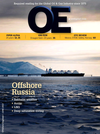
Page 20: of Offshore Engineer Magazine (Jun/Jul 2013)
Read this page in Pdf, Flash or Html5 edition of Jun/Jul 2013 Offshore Engineer Magazine
already implemented.
The research shows that the industry, in general, favors a goal-setting regulatory
Quick stats regime, in which the regulator defnes
OE ’s at-a-glance guide to offshore hydrocarbon
Analysis the goals that have to be achieved and reserves and key offshore infrastructure globally is operators are free to decide how to achieve them. This type of regime is active in the North Sea, and was introduced to updated monthly using data from leading energy the UK’s oil and gas industry in reaction to the Piper Alpha analysts Infeld Systems (www.infeld.com).
incident. Of the respondents, 76% said that a goal-setting regulatory regime was most effective in improving safety
New discoveries Pipelines performance. There has typically been a more prescriptive (operational and 2013 onwards) announced approach taken in the US. (last
Depth (km) month) range 2010 2011 2012 2013
The danger with a prescriptive system is that an operator <8in
Shallow 92 103 72 11 is able to act within the letter of the regulations and then (<500m)
Operational/ (42,570) stop, having “fulflled” its duty. In the UK and many other 42,633
Deep 28 25 23 4 installed (500-1500m) regimes, in contrast, the onus is on the operator to think
Ultradeep Planned/ 30 20 34 8 (22,133) 23,170 (>1500m) through its own challenges and issues, and to demonstrate possible 150 148 129 23
Total (64,703) 65,803 that it has understood the risks and acted accordingly.
Note: Operators do not announce discovery
It is due, in part, to the goal-setting approach that UK regu- dates at the time of discovery, so totals for 8-16in previous years continue to change.
lation has worked since Piper Alpha. By placing the empha-
Operational/ (77,929) 77,886
Reserves in the sis on the operator to recognize and meet its ALARP goals, installed
Golden Triangle and with such a goal not being an absolute, the operator
Planned/ by water depth 2013-17 (47,240) 47,482 possible needs to constantly strive to reduce risk. Regulations remain
Water Field Liquid Gas (125,169) 125,368 depth numbers reserves reserves applicable even as oil and gas industry practices, technolo- (mmbbl) (bcf) gies, and operating environments evolve.
Brazil >16in
In the North Sea, for example, a number of changes have
Operational/ 25 3,236.75 1,680.00
Shallow (88,308) 88,353 installed occurred to the commercial arrangements under which plat-
Deep 16 3,257.00 2,555.00
Planned/ forms are operated, since the UK regulations were drafted. (47,362) 47,758 40 12,428,45 17,340.00
Ultradeep possible
Many platforms are operating beyond their original design (135,670) 136,111
United States life expectancies. New projects and tie-backs place new 21 96.45 1,253.50
Shallow demands on existing infrastructure. However, the largest
Production 26 1,898.71 2,124.87
Deep risks still relate to the integrity of assets and the shrinking systems worldwide 24 2,925.00 3,340.00
Ultradeep (operational and 2013 onwards) levels of production that are there to support them. The (last
Floaters goal-setting regime in the UK has been able to cope with
West Africa month) (272) 150 3,378.60 18,217.81 274
Shallow Operational these changes over the last 20 years, with only minor amend- (47) 47 5,574.00 6,420.00 46
Deep Under development ments, and this has helped the UK industry beneft from 16 2,540.00 3,000.00 315 (320) improved safety performance.
Ultradeep Planned/possible (639) 635
Total 365 35,334.96 54,631.18 (last month) (372) (37,966.37) (54,592.09)
Learning from goal-setting regimes
Fixed platforms
Unlike goal-based regulation, a prescriptive approach is not
Greenfeld reserves (9,876) 9,878
Operational able to evolve in with industry practices and is not able to 2013-17 148 141 ( )
Under development
Water Field Liquid Gas guard against future disasters. New technology that was not (1,438) 1,467 depth numbers reserves reserves
Planned/possible (mmbbl) (bcf) envisaged when the regulations were written could fail, with (11,455) 11,493 1,349 78,930.66 837,296.39
Shallow tragic results. This can make industry professionals question (last month) (1358) (79,677.08) (840,869.86)
Subsea wells the regime under which they are working and its ability to
Deep 171 14,524.58 87,046.57 (4,420) 4,426
Operational (last month) (172) (15,008.74) (87,092.48) guard against major disasters.
(387) 393
Under development
For this reason, many countries look to goal-setting 99 18,322.45 67,197.00
Ultradeep (last month) (104) (20,438.20) (65,907.00) (5,959) 5,981
Planned/possible regimes—such as those of Norway and the UK—when estab- (10,766) 10,800 1,619 111,777.69 991,539.96
Total lishing their own regulatory framework. GL Noble Denton is currently working with governments across Europe and the
Global offshore reserves (mmboe) onstream by water depth
Middle East to help create new goal-setting legislation for 2011 2012 201320142015 20162017 their oil and gas industries. 10,429.53 6,125.23 65,466.32 34,157.68 41,087.23 31,629.57 54,574.12
Shallow
In Ireland, we have been working with the Irish (last month) (10,431.06) (6,255.23) (68,939.80) (31,391.27) (41,138.09) (32,272.94) (54,548.99)
Commission for Energy Regulation (CER) to introduce new
Deep 1,316.732,533.96 3,652.02 5,830.40 3,968.34 5,424.56 10,996.57 upstream safety regulations that cover onshore and offshore (last month) (1,316.73) (2,533.96) (3,667.02) (5,825.60) (4,378.91) (5,422.71) (11,059.66) production. A team of safety and regulatory specialists 199.94 797.15 3,090.44 3,075.06 1,948.73 5,949.75 16,114.35
Ultradeep (last month) (199.94) (797.15) (3,180.44) (3,123.81) (2,432.20) (6,877.27) (16,452.93) has been working with the CER for a number of years to 11,946.21 9,396.34 72,208.78 43,063.14 47,004.30 43,003.88 81,685.04
Total review different regulatory approaches being used around 15 May 2013 the world, to identify the ones most suitable for the Irish
OE | June 2013 oedigital.com 22 006OE_0613Analysis_Qstats.indd 22 5/25/13 12:29 AM

 19
19

 21
21